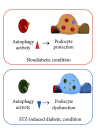The role of autophagy in the pathogenesis of diabetic nephropathy
- PMID: 24455746
- PMCID: PMC3877624
- DOI: 10.1155/2013/193757
The role of autophagy in the pathogenesis of diabetic nephropathy
Abstract
Diabetic nephropathy is a leading cause of end-stage renal disease worldwide. The multipronged drug approach targeting blood pressure and serum levels of glucose, insulin, and lipids fails to fully prevent the onset and progression of diabetic nephropathy. Therefore, a new therapeutic target to combat diabetic nephropathy is required. Autophagy is a catabolic process that degrades damaged proteins and organelles in mammalian cells and plays a critical role in maintaining cellular homeostasis. The accumulation of proteins and organelles damaged by hyperglycemia and other diabetes-related metabolic changes is highly associated with the development of diabetic nephropathy. Recent studies have suggested that autophagy activity is altered in both podocytes and proximal tubular cells under diabetic conditions. Autophagy activity is regulated by both nutrient state and intracellular stresses. Under diabetic conditions, an altered nutritional state due to nutrient excess may interfere with the autophagic response stimulated by intracellular stresses, leading to exacerbation of organelle dysfunction and diabetic nephropathy. In this review, we discuss new findings showing the relationships between autophagy and diabetic nephropathy and suggest the therapeutic potential of autophagy in diabetic nephropathy.
Figures




References
-
- Burton C, Harris KPG. The role of proteinuria in the progression of chronic renal failure. American Journal of Kidney Diseases. 1996;27(6):765–775. - PubMed
-
- Abbate M, Zoja C, Remuzzi G. How does proteinuria cause progressive renal damage? Journal of the American Society of Nephrology. 2006;17(11):2974–2984. - PubMed
-
- Nath KA. Tubulointerstitial changes as a major determinant in the progression of renal damage. American Journal of Kidney Diseases. 1992;20(1):1–17. - PubMed
-
- Peterson JC, Adler S, Burkart JM, et al. Blood pressure control, proteinuria, and the progression of renal disease: the modification of diet in renal disease study. Annals of Internal Medicine. 1995;123(10):754–762. - PubMed
-
- Brenner BM, Cooper ME, De Zeeuw D, et al. Effects of losartan on renal and cardiovascular outcomes in patients with type 2 diabetes and nephropathy. The New England Journal of Medicine. 2001;345(12):861–869. - PubMed
Publication types
MeSH terms
LinkOut - more resources
Full Text Sources
Other Literature Sources
Medical

